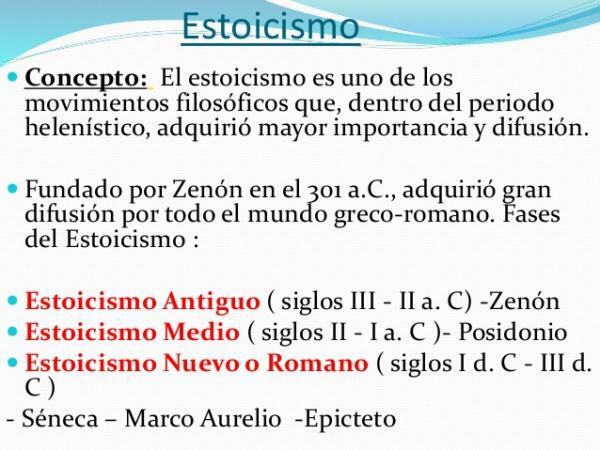STOICS in philosophy: definition and characteristics

Image: Philosophy & co.
In this lesson from a PROFESSOR, we will give a simple definition of the term Stoic and we will explain what are the main characteristics of this current of philosophy that bets on the “life worth living”As the basis of happy life, something that includes, in addition to the imperturbability of the spirit, a certain independence from the outside world, but without renouncing the concern for the rest of the human beings and for public life. The founder of this philosophical school was Zenón de Citio, in the year 301 a. C, when he began to impart his teachings in the this or portico, hence the name. If you want to know the definition and characteristics of the Stoics in philosophy, Keep reading this lesson!
Stoicism is a philosophical school founded by Zeno of Citio in the year 301 a. C and that proposes a philosophical doctrine based mainly on a disposition of spirit, apathy and that is similar to the ataraxia, the ideal of epicureans and the skeptical. Apathy will allow the emotional balance necessary to be happy. This consists of reducing the intensity of human desires and passions and strengthening the soul, against the adverse circumstances, is synonymous with tranquility and spiritual peace and is what will allow the human being to achieve happiness.
And in this sense, discipline is essential, the domain of passions. It is necessary, therefore, to moderate human appetites, learn to accept the ills of life and give up desires when they cannot come true.
“A bad feeling is a concussion of the mind repugnant to reason, and against nature”. Zeno of Citio.
Difference between Stoics and Epicuros
But how does the stoic ideal, apathy, differ from epicurean and skeptical ataraxia? The most important difference between these two predispositions of the soul is that apathy is committed to elimination of passions and desires for a happy life, while ataraxia promotes spiritual strength in the face of bodily pain and adverse circumstances. But in the end, the two states lead to the same thing, total indifference or imperturbability of spirit.
“Thought must be stronger than matter, and the will more powerful than physical or moral suffering.”. Zeno of Citio.
Apathy, like ataraxia, leads to freedom, understood as the absence of passions, affections and appetites. But also freedom from the influence of others or adverse circumstances. Apathy implies, in addition to a total control of everything that can disturb life, and therefore, there is to have enough courage and intelligence, to renounce passions, to control the will. Apathy also supposes dispense with material goods in order to achieve full and happy life.
Stoicism was very popular in the Hellenistic period, especially among the Roman elites, and its decline coincides with the rise of Christianity. Among the most prominent Stoics are Epictetus, Seneca, or the Roman Emperor Marco Aurelio.
“Everyone is as miserable as they imagine to be”. Seneca.

Image: Slideshare
Next we will analyze the characteristics of Stoicism so that you can better know how it differs from the rest. They are as follows:
1. Live according to nature
Stoic philosophy associates happiness with living according to Nature, which means accepting one's own destiny. Only what depends on oneself can be defined as good or bad, and the opposite will be totally indifferent. We see, then, that morality is what is opposed to the indifferent. Because only the intention depends on the human being. The rest depends on nature, on others.
2. Indifference to adverse circumstances
Life and death, health and disease, pleasure and suffering, must be totally indifferent to the human being, since it does not depend on it. These are things of fate, and therefore they should not concern you.
“NOr do you make sure that what happens happens the way you want it, otherwise you want what happens to happen as it happens, and you will be happy”. Epictetus.
3. Responsibility for one's life
All human beings are responsible for their own life, although it separates those fields of it that depend on them, on which they do not depend. People only have power over themselves.
“All my goods are with me”. Seneca.
Up to this point moral intention is important, which becomes the foundation of Stoic ethics.
4. Individual empowerment
Stoic morality is aimed at strengthening the body and soul, educating it so that it can bear pain, hunger, deprivation of freedom, in short, of one's own destiny.
5. Acceptance of one's own destiny
For the Stoic, it is necessary to become aware of the situation of the human being, tragic, mainly, because his life does not depend on him, but on the circumstances. That is, he is conditioned by his own destiny.
Nothing in life depends on his will, except his intention, therefore, he has to be indifferent to adversity. Who does not know this, will live between the anguish of not seeing his wishes satisfied and the desire to accumulate material goods. Only by accepting one's own destiny can the necessary degree of coherence be achieved, the point where the thought and action coincide, that is, it is a prefect state of peace, imperturbability, serenity, apathy.
6. Live in the present moment
The above leads the human being to live the present experience, because the past is gone, it is gone, and the future is uncertain, it is therefore absurd to worry. There is therefore no point in worrying about death, since it is inevitable.

Image: philosophy project



